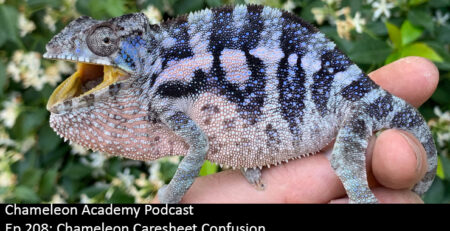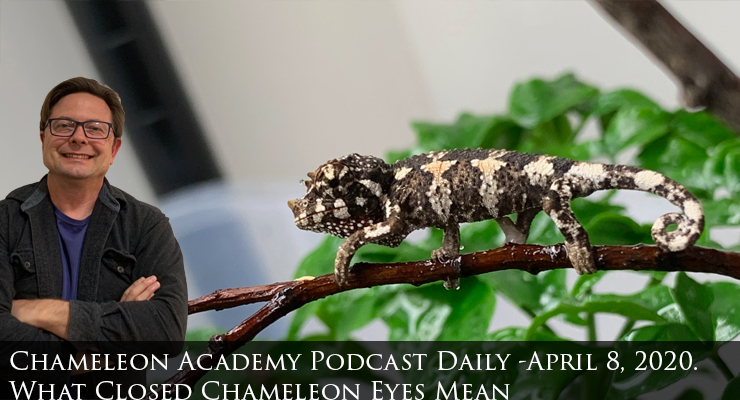Brumation in Chameleons
Brumation is the slowing down of activity that chameleons do when the weather gets cold. This is a normal, healthy part of a chameleon’s life, but may be concerning to the keeper who is seeing it happen the first time. We are going to talk about what brumation is and how you should react if your chameleon is going through a winter slow-down.
Note: This topic is discussed in the weekly Chameleon Academy Newsletter and is reviewed in a YouTube microlearning Live video. Click here to join in with the weekly newsletter discussions: Chameleon Academy Newsletter sign up
Video Player

What is chameleon brumation
Brumation is a term that was coined for reptiles to describe the slowing down that some species go through to survive the winter. Scientists needed a term to describe what reptiles do during the cold months. Since chameleons react to the cold seasons on a wide scale, the term has general meaning for us chameleon keepers.
Chameleons will wait out the cooler months, where food is scarce, with everything from just staying still on a branch to hiding in rocks, stumps of trees, or holes in the ground. In captivity we see the starting of brumation in a typical winter slow down of activity. Parson’s Chameleons, though, are a species that have a distinct brumation drive and seem, at least in my experience, to go through one every year. Other keepers have avoided brumation by keeping temperatures in the normal range. This is sometimes done with hatchlings for the first year or two to keep them growing.

What does a chameleon do during brumation?
Every species will slow down with lower temperatures. Those species that are from areas where there is a distinct cool season, such as South Africa, Madagascar, and the Mediterranean area are more likely to have a programmed response to the cool season. Although Panther Chameleons have been reported to hide in holes to escape the dry season we usually don’t see that in captivity. I have seen some brumation-like signs in my Shamrock Chameleons (Calumma oshaughnessyi), but it is the Parson’s Chameleon (Calumma parsonii) that is the highest profile captive kept species that shows brumation signs.
During brumation, the chameleon will slow its functions down. Being in Southern California, I have not been able to trigger brumation in a South African Dwarf Chameleon, but my Parson’s Chameleons will go into brumation each year. The switch between Madagascar seasons and Northern hemisphere seasons is a challenge to switch around for breeding purposes, but for brumation it seems to take little time at all. Which makes sense as it is triggered by the falling temperatures. They will still be awake during the day and may move around, but have no interest in feeding. This can be concerning to the diligent chameleon keeper, but a healthy Parson’s Chameleon will have no problem going through a brumation period. In their low activity state they do not burn many calories. I offer my Parson’s a single food item every other day just to see if there is any interest. Usually there isn’t much interest, but one day, when temperatures start warming up, there will be a sudden surge in interest and they will be back to their old selves. Once the brumation is broken I give them as much food as they will eat for the first week or two before settling back to a standard food schedule.

Should we brumate our chameleons in captivity?
At this time we don’t have much understanding of brumation other than they slow down for the cold season. And I do not think we even have a definition of where the normal winter slow down stops and brumation starts. We have so much to learn about the slow down/brumation period that it is hard to make any definitive judgments as to whether we should handle it differently than we are. (Which is, essentially, to let the chameleon just adjust to the season fluctuations that our home presents to it.) There is not much in the way of scientific literature on chameleon brumation. Linked below is an interesting observation, though!
My personal belief is that a cool down period is natural and makes sense that a prolonged rest period would also prolong life span. We all know that giving our body rest strengthens our immune system and keeps us running healthy. So, maybe I need to brumate myself here and there!
There has been discussion of skipping the first couple brumation seasons for captive hatched Parson’s Chameleons. The idea is that they are still in their growth stage and we don’t want to interrupt that. Once again, we are still exploring how we use brumation in captivity.
Conclusion
What is important for you, especially if you keep a Parson’s Chameleon, is to recognize that it is natural for chameleons to demonstrate a seasonal slow down when it gets cold. Panther chameleons may take on duller colors and Parson’s Chameleons may be less responsive. And they all may eat less. Each chameleon will react differently to the change in seasons. For your part, don’t panic if your chameleon slows down. Continue to hydrate and offer food. They will bounce back in the Spring!
Join me for a weekly discussion about chameleons
Thank you for being part of this chameleon academy outreach. As always, every week has a topic which is presented in the weekly chameleon academy email newsletter. You can join the conversation by subscribing tot the newsletter yourself. The newsletter is a serious outreach for me. I know you are used to getting newsletters that are haphazardly thrown together to check a to-do box. But I put a great deal of effort into figuring out what is best for the community, where I want to take my herpetoculture, and writing substantial educational newsletters. So, try it out and see if it gives you the chameleon fix you are looking for!
And with that, I think it is time to send you back out into the world to be excellent to each other!
You can sign up for the newsletter here: Chameleon Academy Weekly Newsletter
And, with that, I think it is time for us to go out into that world and be awesome! Thank you for joining me on this journey to explore chameleon husbandry and the relationship between us and our chameleons. This is Bill Strand signing off. I will see you next time!















Leave a Reply